There were lots of cool observations this afternoon so this is going to be a long but informative post.
Our bus headed to two neighbourhoods – Falls Road and Shankill Road. During the 60s, these areas were the sight of fierce fighting known as The Troubles. Our guide explained what the Troubles were and pointed out points of interest. Simply put, it was a clash of ideologies – people who wanted a united Ireland and those who wanted Northern Ireland to retain its loyalty to the British crown.
Murals are used by the people when they feel they do not have a voice. We saw some of that in Glasgow. However the murals in Belfast are much more political. Here is a famous one of Bobby Sands. He was a republican who died in prison on a hunger strike in 1981. The Troubles would last until the signing of the Good Friday Agreement in 1998.

Both Falls Road and Shankill Road were working class neighbourhoods. There is high unemployment and social problems. The difference is in religion. The Falls Road is exclusively Catholic. Their politics is Irish Republican – uniting Ireland and Northern Ireland into one republic.
The voice of the Irish Republican Army was censored by the British Broadcasting Corporation so they turned to murals (among other things) to get their message out.
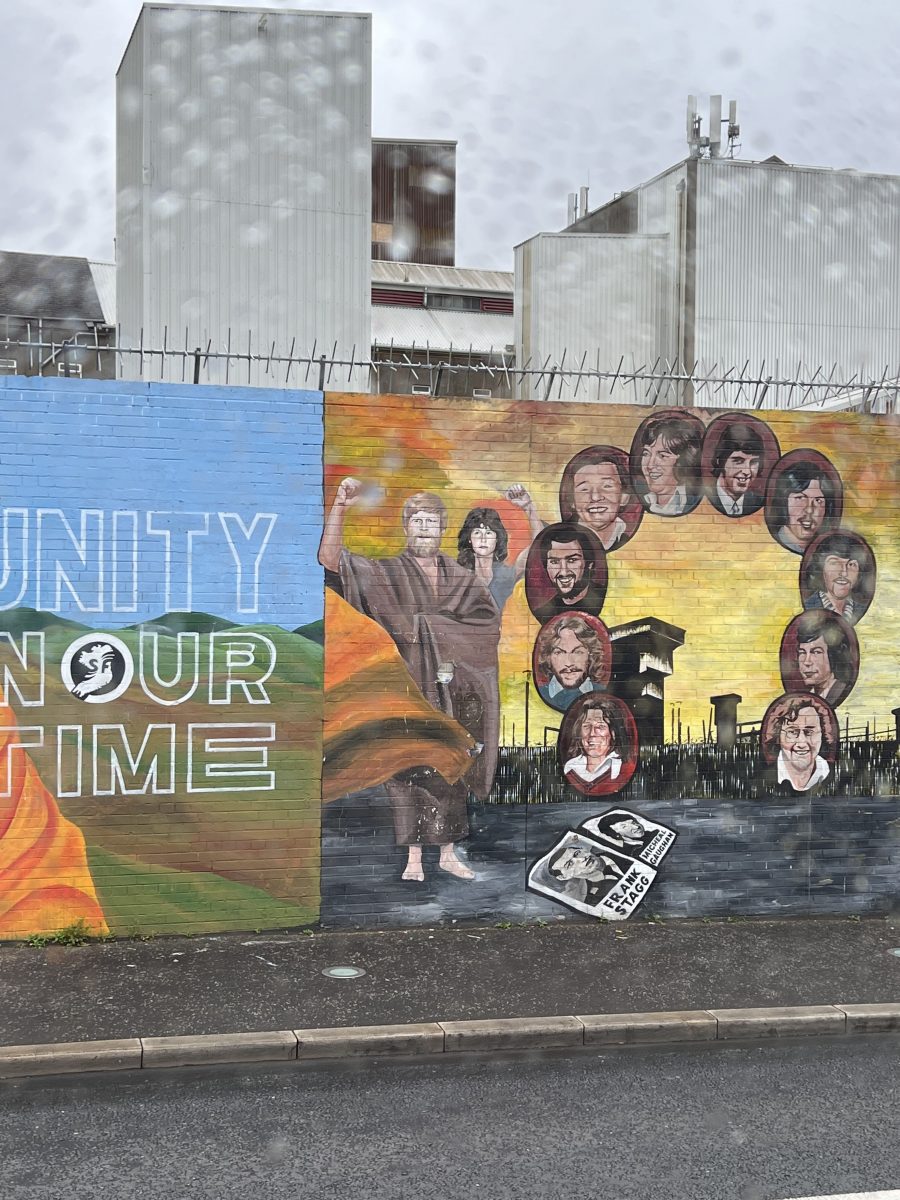
The Shankill Road area is Protestant. They consider themselves to be British. They don’t want a united Ireland. They are loyalists. The clash was more than just religion – it was national identity. This was the main cause of The Troubles.
If you’ve seen Anthony Bourdain’s trip to Belfast in “No Reservations”, he explored this conflict. Tony took a Black Taxi tour of Falls Road with a Catholic driver. Then he took a tour of Shankill with a Protestant driver. Then, Tony being Tony, brought the two of them together for pints in a pub to discuss what he saw.
During the Troubles, the bus service on Shankill and Falls road were discontinued. A bus would be used to block a road. So dilapidated black taxis, bought in London, were used as community transport.

These series of murals are painted on the wall dividing the two neighbourhoods. We were on the side of the Catholics so the murals depict their message. There are also murals on international issues like Palestinians and local social injustice issues.

In addition to sectarian civilians fighting, there were Irish paramilitary groups and British Security forces. The British Army were stationed in the top two floors of an apartment building, with helicopters on the roof. People knew trouble had started once they heard the choppers.
The wall was built in 1969 to stop the Catholics and Protestants from killing each other. The police station seen here ensured there was a quick response to any trouble.

Other walls were put up throughout Belfast in order to maintain the peace – 66 walls in all. The gates were locked each night at 7 pm and opened 6 am the next morning. This was to stop murder gangs from going into each other’s neighbourhoods. The metal fence was added to prevent the throwing of petrol bombs at each other. Now, the gates are left open permanently.

The Garden of Remembrance is dedicated to the people in the IRA who lost their lives. The black, commemorative wall lists their names.
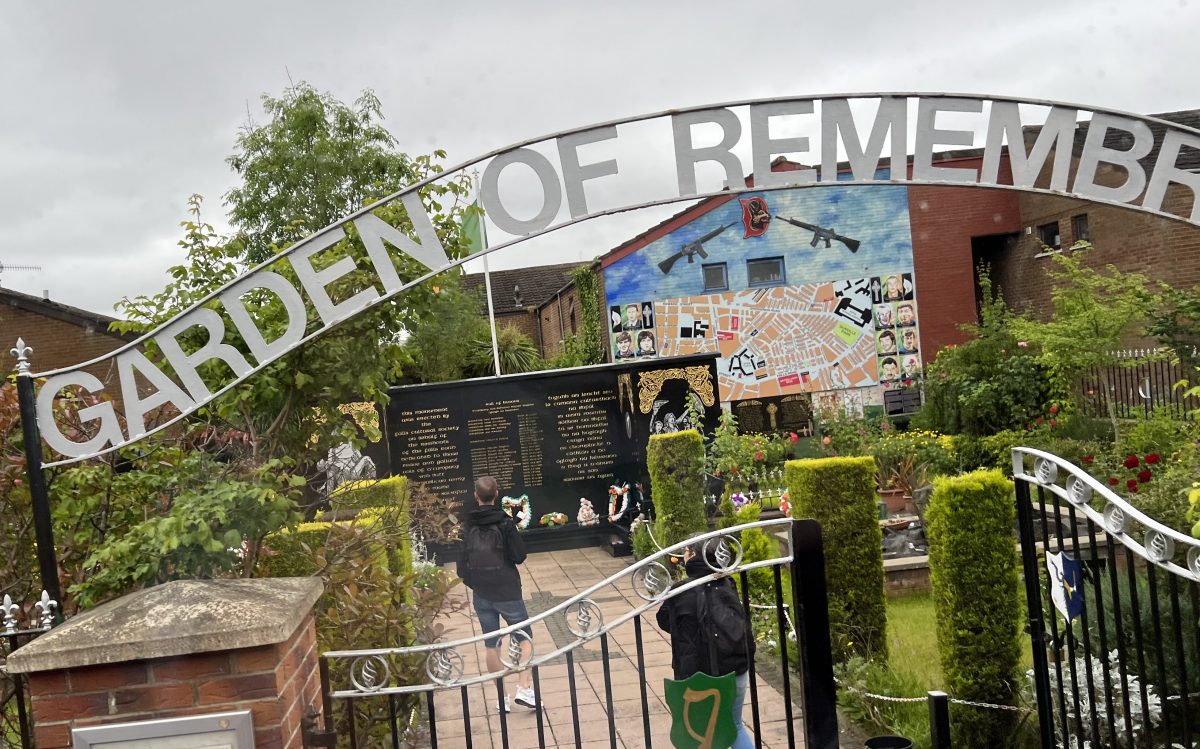
The artwork at the Peace Wall is covered with hundreds of thousands of signatures. When people come to visit the Peace Wall, they are invited to write a message of peace to the people of Belfast. American Presidents, the Dalai Llama, actors and artists have signed it.

This piece caught my eye and decided I would sign it.

Even though the peace agreement was signed in 1998, the walls remain. Sectarian violence has been happening in Northern Ireland for 400 years so 24 years is a drop in the bucket.

Belfast is a different climate than in 1969. But it will take time to adjust. Each generation will make an improvement to the adjustment.

Now in the Shankill Road district, they are celebrating a British event. There is an area set aside for a bonfire. Someone has already started the fire. The houses have to have their windows boarded because the intensity of the great bonfire will warp the frames.

The whole month of July is Marching Season so the British flag is proudly displayed. July 12th is the big parade day when everyone comes out. This mural is from the Queen’s Jubilee celebration.

A mural dedicated to the Ulster Volunteer Force.

A pub using the scaffolding to prepare for July 12th. Also note the support for the Glasgow Rangers

Crumlin Road Gaol no longer holds prisoners. It is now a tourist attraction and conference centre. They have music nights like “Jailhouse Rock”. And you can even have your wedding there.
Both buildings were designed by Charles Lanyon who designed the Queen’s University from the previous post. There was no execution wing in the design because executions were public and took place in the city centre. In 1860, that changed and the official English executioner would visit twice a year to do any hangings. The last hanging was in 1961.

Across the road is the courthouse. The gaol and courthouse are linked by an underground tunnel. The courthouse is both derelict and for sale. I found it interesting that the city choose to preserve the gaol but not the courthouse. It was purchased by a hotel group and got permits to turn it into a hotel. But the pandemic bankrupt the company.
So if you want to go into the hotel business, here is a good opportunity.

The St Anne’s Belfast Cathedral and the largest Celtic Cross in Ireland.


The Titanic Hotel was the original offices of Harland and Wolff. The drawing room is where the Titanic drawings were done by hand. It is now the hotel’s bar. So if you go in for a drink you can say you sat where the Titanic was designed.

The Harland & Wolff cranes are still sometimes used.

We are now heading to the Titanic Museum. However we are also entering Game of Thrones territory. The Titanic Studios where all the interior scenes of Game of Thrones was shot. Over the course of 11 seasons, the show brought a lot of employment to Northern Ireland. You can take a studio tour. There are also day long bus tours that take you to various locations, including Winterfell where you can practice your archery.

Below is the set for the final episode. The buildings were set on fire to create the dragon scorching the city.

The Titanic Belfast building is located next to the slipways where the Titanic was built. It is located in an area known as the Titanic Quarter – derelict lands that was regenerated in 2001. The building was designed by American architect Eric Kuhne and British exhibition designers Event Communication. It is the exact hight of the Titanic ship.

The short and long wooden benches represent the last SOS Morse Code signal that the Titanic sent out before sinking.
The tour begins at the 4th floor and you work your way downwards. The 4th floor gives background to the city of Belfast – industry, culture, history. The next floors are a series of exhibits that describe the design and building both the Titanic and the Olympic. Then the events surrounding the sinking. And the aftermath, the investigations and influence in the media.
I didn’t take any photos – it was quite overwhelming. Spent the time reading the exhibits material and thinking about what had happened.

The SS Nomadic is on display outside the museum. It was used to transfer passengers from shore to the Titanic. It is the only surviving vessel designed by Thomas Andrews – who designed the Titanic. It changed hands over the years, including being converted to a restaurant in Le Havre, France. It was almost scrapped several times. Several financial campaigns by private groups and government funds succeeded in purchasing the Nomadic in 2006. It was returned to Belfast where is was restored and displayed.
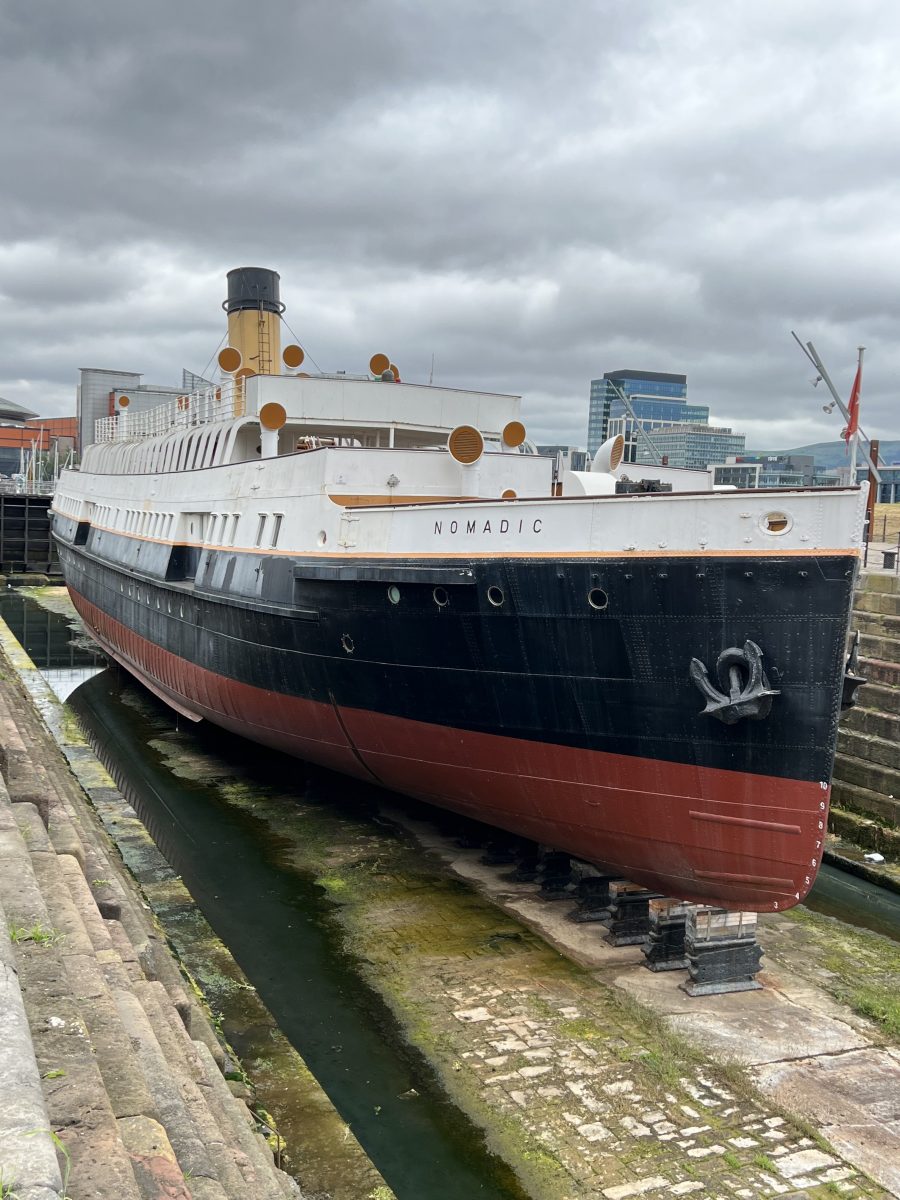
The bus was taking everyone back to the hotel but I decided to walk. The Titanic Quarter has been rejuvenated with a waterfront promenade. But I also wanted to see some White Walkers. This is another Game of Thrones moment so feel free to scroll down to the big fish if you are not a fan.

To celebrate 10 years of making Game of Thrones in Northern Ireland, Tourism Ireland commissioned 6 giant stained glass panels. They depict the most iconic scenes from the show. They were unveiled during the 11th and final season. the White Walkers panel is a short walk from the Nomadic. Hodor, holding the door against the dead, is the centre figure. The Night King riding his ice dragon.

The House Targaryen panel. It includes the gripping moment when brother Visery’s head is covered in molten gold – giving him his crown.


House Baratheon with the Red Woman centre, Gendry’s war hammer…

Renley’s death from Stannis’s shadow…

And Joffrey’s poisoning

Now, some art in a totally different direction. The is “The Big Fish”. It is also known as The Salmon of Knowledge. You can read the Salmon of Knowledge story here

Constructed by artist John Kindness it was a celebration of the regeneration of the River Lagan and the return of salmon to the river. The fishes scales are ceramic tiles. Each one depicts some history of Belfast – from Tudor to the present day.

The eyes are a print of the harbour taken from the crane of Harland and Wolff. Constructed in 1999, the fish contains a time capsule. Below the fish, underground, is the confluence of the River Farset – which is no longer around. Belfast was named after the River Farset.

I headed back to McHughes pub where we saw the step dancer. Sat down with a pint of Guinness and enjoyed the vibe. The main floor walls have murals depicting some of Belfast’s history.



Passed by a famous landmark of Belfast – the Albert Clock. Built in 1865, it was a memorial to Queen Victoria’s late consort Prince Albert. It was designed by W.J. Barre who also did the Ulster Hall in an earlier post. It was built on marsh soil so it leans. It was damaged by a bomb set off by the Irish Republican Army. And a bullet hole can be seen in one of the lower statues. It had a major restoration and strengthening in 2002.

We were having our group dinner at a restaurant called Sticks and Stones. Our tour manager Jayne and phoned around to get a group booking and this place was the only one who could accommodate us. It turned out to be really great. They served the grill items on hot stones. So the meat cooked while at your table.

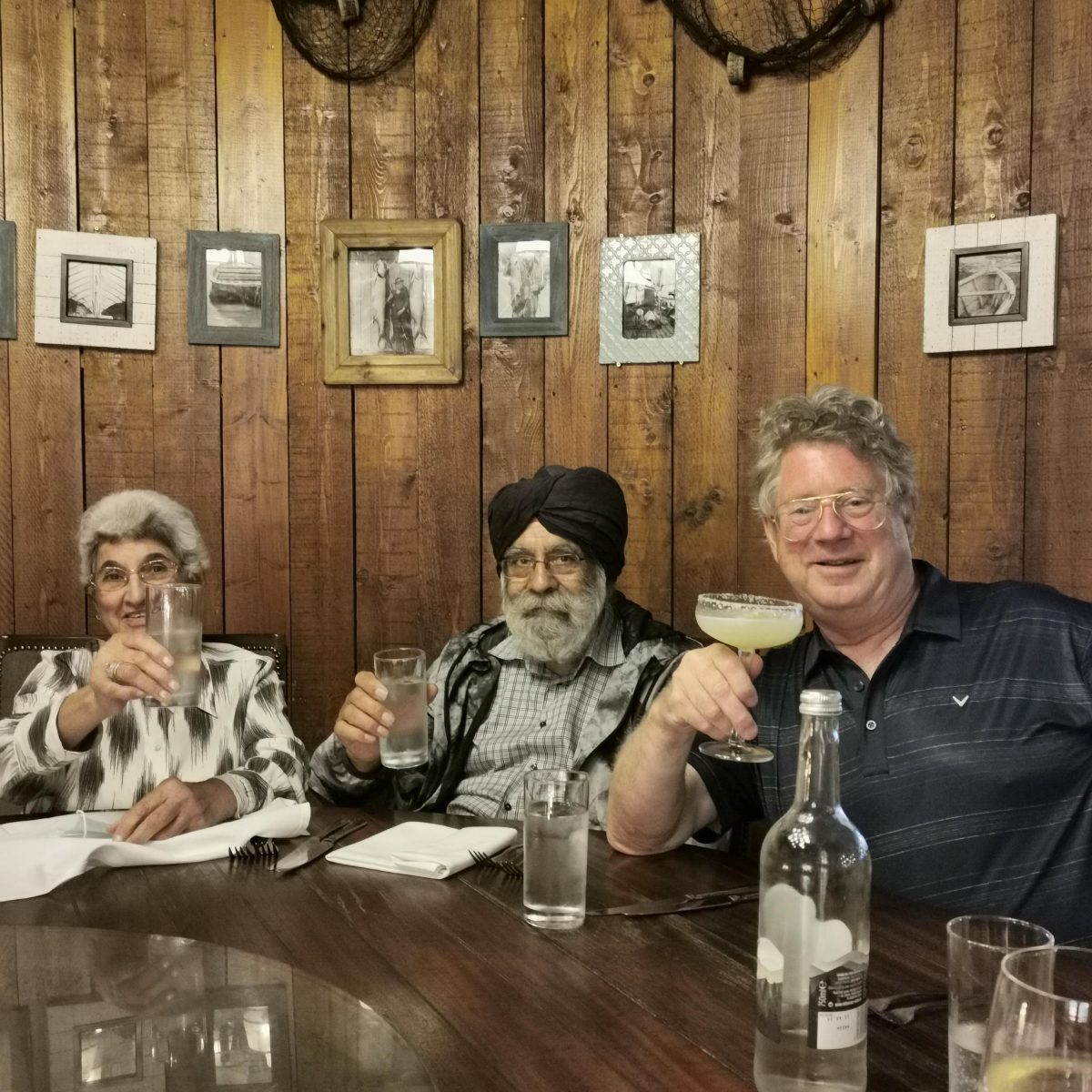


Ended off the evening with an Irish Coffee. The only trouble we had was, at the end, the server had put everything on one bill. So we all had to calculate what we owed. After counting it up, we were still 20 pounds short. Eventually it was worked out (I think).
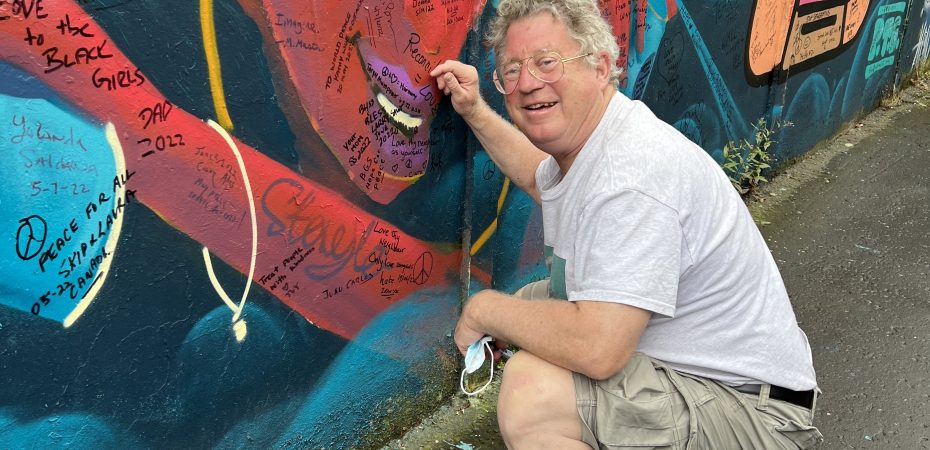
Thanks for sharing, Belfast is a very lovely and interesting city, which sometimes get over looked. When I was in Belfast I stayed at The Europa Hotel the most bombed hotel during the troubles. Did you see the picture of William Pirrie, chairman of Harland and Wolff and Lord Mayor of Belfast, I’m related to him by my paternal Montgomery side.
Hi Larry, Ann here….absolutely enjoying every moment of your Scottish and now my home town, Belfast trip. FYI…my great grandfather worked on the pilot boat that took the Titanic down the Belfast Lough after it’s launching.
Have to correct you though. During the troubles the busses did continue to operate around most of the city. Just not up the Falls or Shankill Roads. That’s when the ‘Black Taxis’ as we called them came into use for those areas.
Looking forward to continuing on with you journey. It’s ‘brilliant’ as they say back home! 😉
Thanks Ann. What a connection to the Titanic story. I’ll make the clarification about the buses.
The Titanic experience was one of the sights I was most looking forward to, so thanks for doing this and allowing me to at least get a fleeting glimpse of what we were unable to see.